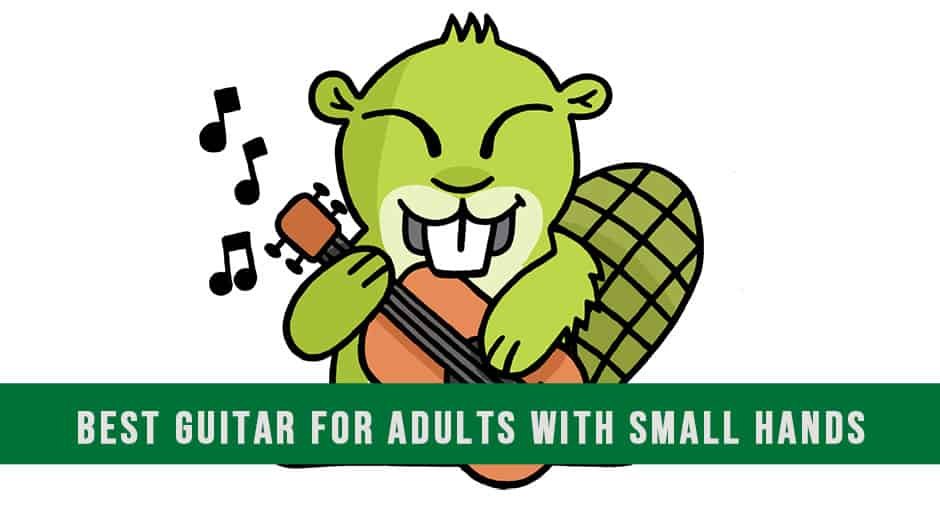
Players with small hands need a classical guitar that feels both comfortable and is uncompromising in quality of sound. A scale length of 630 mm strikes a good balance they seek.
For someone starting out or in their first year of exploration, I’d strongly recommend the Cordoba Dolce which has a 630 mm scale length and is a fantastic choice in other ways too. Check the price of a Cordoba Dolce at Amazon. Or check it out at Guitar Center.
Before we discuss that choice in some detail, a word about ‘fractional guitars’ in general.
Table of Contents
What do the fractions mean?
Let’s get past the confusing industry terminology.
Scale length is the distance between the bridge and the nut (near the tuning pegs). On normal, full-size guitars, the scale length is 650 mm. There are various sizes available for the classical guitar, which is to say there are guitars of varying scale lengths – 640 mm, 630 mm, 613 mm, 580 mm and so on.
Yamaha uses ‘7/8 size’ to refer to its 630 mm scale-length instruments. Cordoba uses ‘parlor’ as a term to define its 630 mm range, as in Cordoba C10 Parlor.
Most other brands use fractions, not names. These fractions, while not mathematically accurate, are directed at the general public to help them understand broad divisions. The various terms used as fractions are give below (along with their translation):
| Size | Translation |
| 4/4 guitars | full size, normal |
| 7/8 guitars | slightly less than full size, don’t worry |
| 3/4 guitars | noticeably less than full size, you must be a child |
| 1/2 guitars | seriously less than full size, you are a small child |
This classification is not standard. For instance, the German made Ortega guitars have their own 7/8 range but with a scale length measuring 613 mm rather than the 630 mm we settled on just seconds ago.
I think we’d all do well to not fall for fractions. As consumers, it makes sense to fix on 630 mm as the number to steadfastly keep in mind. Or, 24.8 inches if you prefer.
Let the manufactures call their products what they will, but we will look for a scale length of 630 mm.
Why the Cordoba Dolce?
For an early beginner to advanced beginner, this is a fabulous choice. For one, it has a solid cedar top, not a laminated one. Solid woods are the prerogative of costlier instruments and are generally not seen in this price range. That’s a straight win, because the top wood has the most direct bearing on the sound of what is essentially a wooden instrument.
Besides the top wood being solid Western Red Cedar, the back and sides are Mahogany, not solid, but a good and standard choice of wood. Like most Cordobas, the Dolce has a Spanish fan bracing which is the arrangement of wooden struts under the top. The bracing too has a bearing on resonance.
Again, for a guitar in this price range, the Cordoba Dolce has a two-way truss rod to adjust the neck angles. You won’t be using it often but it’s great that it is there.
Again, as an indication of its quality build, the nut and saddle are made of bone, not plastic. This too is uncommon at this price range.
These are all good features for the price and the guitar will keep a student good company at least for a couple of years, if not more.
And, oh yes, even though the company does not call it a Parlor guitar – it’s called Dolce – it is very much a 630 mm guitar. Just right for those with small hands.
Even for more advanced players who want to check if going down to a 630 mm will improve their playing experience and comfort will do well to check this guitar out. It will certainly help them decide, at not much cost, if they want to stay with the small size for the rest of their playing days.
Check the price of a Cordoba Dolce at Amazon. Or check it out at Guitar Center.
For the more experienced player
What I recommend for the more experienced, intermediate player (with small hands) is the respectable Cordoba C9 Parlor.
You can check the price of the C9 Parlor at Amazon. Or here at Sweetwater.
This is in a different league – in construction, materials, sound and price. This is an all solid wood construction using quality tone woods. The top is solid Canadian cedar and the sides and back are of solid Mahogany. The fingerboard and bridge are of Indian rosewood.
Its nut and saddle are of bone, not plastic. And it comes with a two-way truss rod to adjust the neck angle. It has the Spanish fan bracing. It is lightweight (as Cordobas are known to be) with a robust sound, described as punchy mid-range heavy.
The company calls the senior C9 as a “concert-level instrument at an affordable price”. While that may or may not be accepted by every player, this much is clear: the C9 is a well regarded instrument and its slightly diminutive cousin, the Parlor, is not at all behind.
Other choices you could look at
One is the younger cousin of the famed Yamaha C40II, known as the Yamaha C40II 7/8. Unfortunately, for reasons unknown to me, this model is no longer seen in online stores including Amazon. And I see no mention of it in the Yamaha US site. Not sure what the future holds.
I’m keeping the mention of this model on this page for now (because it is a seriously worthwhile choice, with all the advantages of the famed, regular size C40). It could be something to do with the Covid-19 days of confusion. Or it may not. In which case, if the situation remains the same after a couple of months, I will pull this off the page here.
You could, at the more expensive end, look at the Cordoba C10 Parlor. There are folks who swear by this. I have not played the Parlor particularly but the bigger size one (C10) is a beautiful instrument. Again, it has all the well made features of a Cordoba, is lightweight and offers a big sound.
For the money though, as already indicated, I will still settle (happily) for the C9 Parlor.
Some things to keep in mind
The issue of whether a small-hands player should look at a smaller instrument at all is a thorny one. A case can be made that adults with small hands don’t need a smaller guitar, they only need improved technique.
Do research this issue to keep a clear head on the matter and why you’re going for what you’re going. I have a review of 630 mm guitars which covers various options, and you should go through that for a better understanding.
My opinion is that if there’s something out there that makes for player comfort (and therefore confidence), then by all means you should go for it. Sure, a total beginner or someone in their early days of their playing will not be able to make this call on their own. They will have to ask their tutor or mentor to guide them.
A more experienced player will have to deal with it as one of the many technical issues that have to be solved in a playing career. A 630 mm guitar, in my opinion as well as many others’, is a happy compromise between comfort and quality.
Even an accomplished guitarist and teacher like Bernard Werner (of ThisIsClassicalGuitar.com) uses a smaller guitar, although of a custom luthier variety.
On that note, even today’s leading high-end luthiers like Kenny Hill or Marcus Dominelli make quality instruments which are of shorter scale lengths. Why would they, if they thought they were somehow inferior?
The 630 mm seems a reasonable choice. There is a 640 mm version too, but I doubt if it makes much of a difference from a regular, full size guitar of 650 mm.
And there are others which are of lesser lengths – 613 mm, 580 mm and so on. The 630 mm is short enough to make a comfort difference while being long enough not to make a quality difference from full size.
To reiterate my choices:
Cordoba Dolce at Amazon – for early to late beginners. Or you can check it out at Guitar Center.
Cordoba C9 Parlor at Amazon – for intermediate students. Or you can check it out at Sweetwater.
Happy choosing!


